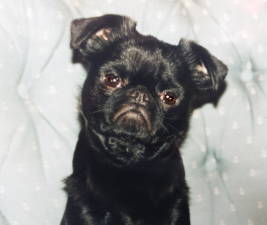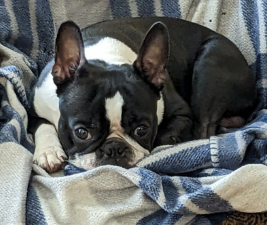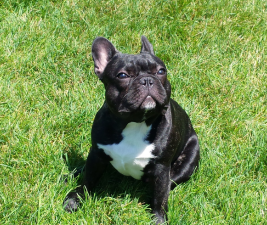Gazing into each other’s eyes is a great way to connect with your dog. But it has to be your dog. Meeting a strange dog’s eyes can be seen as threatening, intimidating, or even cause for aggression. Unless it’s your dog, just don’t stare at dogs.
Sometimes, it’s not even a good idea to stare at your own dog. One of the exercises we practice in competition Obedience requires the dog to stay for a minute, with you six feet away at the other end of the leash. Some dogs need constant eye contact to maintain the position and reassure them that they’re doing fine. On the opposite end of the spectrum, we’ve trained dogs that would move immediately if you made eye contact. For those dogs, we spend a lot of time looking at the space between their ears. We could see what they were doing, but weren’t looking directly at them.
Stranger danger
That’s one of the ways we developed the technique of looking indirectly at dogs we’re just meeting. It seems contradictory that an animal who considers butt-sniffing the height of polite greetings will take offense if you meet their eyes. But there you have it.
When meeting a dog for the first time, it’s a good idea to look slightly to the side until they have a chance to get used to you and relax. When we meet dogs who are considered reactive or even aggressive, we try not to look at them at all. Instead, while we chat with their people, we randomly throw treats in front of the dog, never looking directly at them. It’s a good way to defuse the problem before it even happens.
They started it
It’s kind of funny to us that people can get defensive about iffy encounters they’ve had with dogs. Maybe the dog was staring at you. That doesn’t mean you have to stare back! Ages ago one of our dogs (Whimsy, pictured, a black, smooth Brussels Griffon) was absolutely fascinated by a friend of ours. He would stare at her for as long as she was with us. We would joke about her being “Whimsy TV.” She’d never done anything negative to him, other than pet him on top of his head, which he loathed. Apparently he decided he had to keep a wary eye on her for the rest of his life.
Because dogs are all unique, there’s no single good way to train. One of the first exercises in most basic obedience classes is to get the dog to “Watch!” As soon as the dog meets the owner’s eyes, the dog gets a reward. For most dogs, this is a fun game and they learn quickly to stare into their people’s eyes non-stop. They wind up walking almost sideways, trying to maintain eye contact.
But it’s not always the case. Apparently herding dogs, like Shelties, use their stares to get the job done. They intimidate the heck out of whatever they’re herding by staring at them. When we had a Sheltie in class, he was the least confident dog in the house and the other dogs kept him cowed by staring. When the owner tried to teach the dog “Watch!” the poor little guy was terrified. It wasn’t the right match for this team.
Know your dog
There’s a saying in dog training that you have to “train the dog in front of you.” That translates into accepting your dog for who they are and adapting to your dog’s preferences. If your dog likes meeting your eyes and finds the direct contact reassuring, go right ahead. If, like the little Sheltie, they think it means they’re in trouble, then avoid doing it.
Funnily enough, the same dogs who avoid eye contact also seem to hate posing for pictures. We’re not sure that dogs recognize a camera lens (or back of a phone) as another eye looking back at them. But we think it’s interesting that they seem to know.
Enjoyed this post? Click here to sign up for the weekly newsletter and never miss another!











